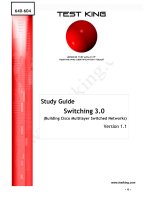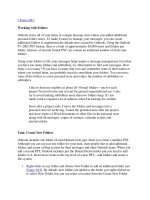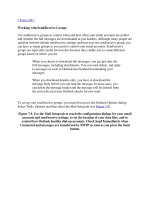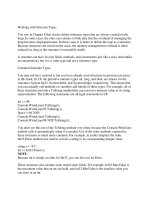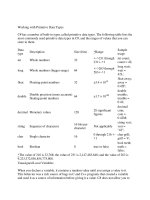Tài liệu Working with NHibernate 3.0 doc
Bạn đang xem bản rút gọn của tài liệu. Xem và tải ngay bản đầy đủ của tài liệu tại đây (16.03 MB, 228 trang )
Benjamin Perkins
Join the discussion @ p2p.wrox.com
Wrox Programmer to Programmer™
Working
with
NHibernate 3.0
Working
with
NHibernate 3.0
www.it-ebooks.info
Working with NHibernate 3.0
Benjamin Perkins
John Wiley & Sons, Inc.
www.it-ebooks.info
Working with NHibernate 3.0
Published by
Wiley Publishing, Inc.
10475 Crosspoint Boulevard
Indianapolis, IN 46256
www.wiley.com
Copyright © 2011 by Wiley Publishing, Inc., Indianapolis, Indiana
ISBN: 978-1-118-10460-6
No part of this publication may be reproduced, stored in a retrieval system or transmitted in any form or by any means,
electronic, mechanical, photocopying, recording, scanning or otherwise, except as permitted under Sections 107 or 108
of the 1976 United States Copyright Act, without either the prior written permission of the Publisher, or authorization
through payment of the appropriate per-copy fee to the Copyright Clearance Center, 222 Rosewood Drive, Danvers,
MA 01923, (978) 750-8400, fax (978) 646-8600. Requests to the Publisher for permission should be addressed to
the Permissions Department, John Wiley & Sons, Inc., 111 River Street, Hoboken, NJ 07030, (201) 748-6011,
fax (201) 748-6008, or online at />Limit of Liability/Disclaimer of Warranty: The publisher and the author make no representations or warranties with
respect to the accuracy or completeness of the contents of this work and specifically disclaim all warranties, including
without limitation warranties of fitness for a particular purpose. No warranty may be created or extended by sales or
promotional materials. The advice and strategies contained herein may not be suitable for every situation. This work
is sold with the understanding that the publisher is not engaged in rendering legal, accounting, or other professional
services. If professional assistance is required, the services of a competent professional person should be sought. Neither
the publisher nor the author shall be liable for damages arising herefrom. The fact that an organization or Website is
referred to in this work as a citation and/or a potential source of further information does not mean that the author or the
publisher endorses the information the organization or Website may provide or recommendations it may make. Further,
readers should be aware that Internet Websites listed in this work may have changed or disappeared between when this
work was written and when it is read.
For general information on our other products and services please contact our Customer Care Department within the
United States at (877) 762-2974, outside the United States at (317) 572-3993 or fax (317) 572-4002.
Trademarks: Wiley, the Wiley logo, Wrox, the Wrox logo, Wrox Programmer to Programmer, and related trade dress are
trademarks or registered trademarks of John Wiley & Sons, Inc. and/or its affiliates, in the United States and other coun-
tries, and may not be used without written permission. All other trademarks are the property of their respective owners.
Wiley Publishing, Inc., is not associated with any product or vendor mentioned in this Wrox Blox.
This PDF should be viewed with Acrobat Reader 6.0 and later, Acrobat Professional 6.0 and later, or Adobe Digital Editions.
Usage Rights for Wiley Wrox Blox. Any Wiley Wrox Blox you purchase from this site will come with certain restrictions
that allow Wiley to protect the copyrights of its products. After you purchase and download this title, you:
• Are entitled to three downloads
• Are entitled to make a backup copy of the file for your own use
• Are entitled to print the Wrox Blox for your own use
• Are entitled to make annotations and comments in the Wrox Blox file for your own use
• May not lend, sell or give the Wrox Blox to another user
• May not place the Wrox Blox file on a network or any file sharing service for use by anyone other than yourself or
allow anyone other than yourself to access it
• May not copy the Wrox Blox file other than as allowed above
• May not copy, redistribute, or modify any portion of the Wrox Blox contents in any way without prior permission from
Wiley
If you have any questions about these restrictions, you may contact Customer Care at (877) 762-2974 (8 a.m. - 5 p.m.
EST, Monday - Friday). If you have any issues related to Technical Support, please contact us at 800-762-2974
(United States only) or 317-572-3994 (International) 8 a.m. - 8 p.m. EST, Monday - Friday).
Associate Publisher
Jim Minatel
Senior Project Editor
Ami Frank Sullivan
Technical Editor
Stephen Bolen
Production Editor
Daniel Scribner
Copy Editor
Luann Rouff
Editorial Manager
Mary Beth Wakefield
Production Manager
Tim Tate
Vice President and Executive Group Publisher
Richard Swadley
Vice President and Executive Publisher
Neil Edde
Proofreader
Nancy Carrasco
Indexer
Robert Swanson
www.it-ebooks.info
ABOUT THE AUTHOR
Benjamin Delcamp Perkins is currently employed at ISOware, GmbH in Munich,
Germany and has been working professionally in the IT industry for more than
16 years. He started computer programming with QBasic at the age of 11 on an
Atari 1200XL desktop computer. He takes pleasure in the challenges trouble
shooting technical issues offer and values the merit of a well written program. After
successfully completing his military service and serving in the Gulf War of 1990, he
received a Bachelor of Business Administration in Management Information Systems
from Texas A&M University.
His roles in the IT industry have spanned the entire spectrum from programmer, to system architect,
technical support engineer, to team leader and management. While employed at Hewlett-Packard,
he received numerous awards, degrees, and certifications. He has a passion for technology and
customer service. Benjamin enjoys sharing his C# and other programming experiences and has
created many free training videos which are available on YouTube. He also has an active blog
found at: www.thebestcsharpprogrammerintheworld.com.
“My approach is to write code with support in mind, and to write it once correctly and completely
so we do not have to come back to it again, except to enhance it.”
www.it-ebooks.info
CONTENTS
CHAPTER 1: GETTING STARTED WITH NHIBERNATE 3 1
What Is an ORM? 2
Creating a Sample Project: The GuitarStore 3
Project Requirements 4
Creating the GuitarStore Solution 5
Creating the Database 7
Configuring NHibernate 10
Downloading and Installing NHibernate 10
Creating the Class Files 11
Creating the Mapping Files 13
Mapping by Code 18
Understanding the property-ref Attribute 19
Configuration Techniques 19
Creating a Console Application for Testing 28
Configuring the GuitarStore WPF Program 30
Initializing NHibernate 30
Adding and Populating the DataGrid Control 30
Adding and Populating a ComboBox 33
Filtering the DataGrid Based on the ComboBox Selection 34
Understanding Lazy Loading 35
Configuring Logging Using log4net 37
The Appender 38
The Logger 39
Configuring Your Program to Use log4net 39
Serializing Startup 40
Serializing the Configuration 42
Validating a Serialized Configuration 42
Loading the Current Serialized Configuration 43
Using a Serialized Configuration 44
Timing the Startup 45
Interceptors and Events 46
Interceptors 46
Events 48
Implementing the Interceptor and Event Classes 49
Summary 52
www.it-ebooks.info
CONTENTS
vi
CHAPTER 2: USING HQL 53
Introduction 53
Working with CreateQuery() 57
Implementing Paging 61
Using the Database Round-Trip Counter 65
Working with Calculated Fields 66
Implementing CreateMultiQuery() 69
Understanding GetNamedQuery() 73
Implementing Aggregate Database Functions
with GetNamedQuery 76
Understanding DetachedQuery 80
Working with DetachedNamedQuery 83
Understanding Futures 85
Summary 90
CHAPTER 3: USING ICRITERIA 91
Introduction 91
Understanding the Stateless Session 97
Working with CreateCriteria 98
Implementing Paging 102
Implementing CreateMultiCriteria 105
Understanding DetachedCriteria 109
Working with QueryOver 112
Using Lambda Expressions 118
Understanding Futures 119
Using FetchMode 123
Configuring FetchMode in the Mapping Files 123
Configuring FetchMode Programmatically 124
Implementing Aggregate Database Functions 126
Understanding Restrictions and Expressions 131
Working with Data Transfer Objects 139
Summary 144
CHAPTER 4: USING LINQ TO NHIBERNATE 145
Introduction 145
Working with LINQ to NHibernate 148
Implementing Paging 153
Understanding LINQ to NHibernate with
Lambda Expressions 157
Understanding Aggregate Database Functions 164
Summary 168
www.it-ebooks.info
CONTENTS
vii
CHAPTER 5: MANAGING STATE AND SAVING DATA 169
Introduction 169
Understanding Concurrency 170
Creating an IUserType 175
Inserting Data 180
Inserting a Parent/Child into a Database 185
Understanding NHibernate Caching 187
Using the First-Level Cache 188
Implementing the Second-Level Cache 190
Understanding Evict(), Merge(), and Persist() 194
Using Evict() 194
Using Merge() 195
Using Persist() 198
Executing Batch Processes 198
Summary 202
CHAPTER 6: USING NHIBERNATE WITH AN ASP.NET
MVC 3 APPLICATION 203
Installing ASP.NET MVC 3 204
Adding an ASP.NET MVC 3 Project to
the GuitarStore Solution 204
Configuring NHibernate 204
Adding References to the Binaries 205
Adding connectionString to the Web.config File 205
Configuring the ASP.NET MVC Program to Use
a session-per-web-request 207
Configuring the View and Controller 208
Summary 212
INDEX 213
www.it-ebooks.info
Getting Started with
NHibernate 3
My first experiences programming data-driven computer systems required registering COM
objects with the regsrv32.exe, invoking the Server.CreateObject method to create an
ADODB.Connection and ADODB.Recordset, and then using the MoveFirst(), MoveLast(),
MoveNext(), and MovePrevious() methods that navigate, forward only, through the result
set. At the time, the practice was groundbreaking technology. The ADO data access technique
laid the foundation for the next advancement, which Microsoft released in late 2005, ADO
.NET. In late 2005, Microsoft released the .NET Framework version 2.0. Programmers
said goodbye to regsrv32.exe, COM, and a whole lot of other unwanted features of a
nonmanaged code way of life.
ADO.NET provided programmers with an object-oriented, or component-oriented, approach
to creating data-driven computer systems. Programmers were able to isolate the SQL queries
from the database connection, and the business logic from the data implementation logic. This
multi-layered capability greatly reduced the complexity and the unwanted side effects caused
by changes, while increasing the speed with which new or enhanced features are introduced.
However, despite the many new features and advancements provided by ADO.NET,
programmers still faced difficulties developing data-driven software applications, including
the following:
➤ Using multiple database management systems (DB2, Oracle, SQL Server, etc.)
➤ Easily responding and adapting to changes in data structures
➤ Managing the connection between computer system and database
➤ SQL injection
1
www.it-ebooks.info
CHAPTER 1: Getting Started with NHibernate 3
2
➤ Database concurrency
➤ Performing complex SQL operations without specialized technical skills
The next generation of data-driven software solutions is upon us. This next generation is called
object-relational mapping, or ORM. Programmers can now say goodbye to the data access
layer and numerous SQL queries, to the methods returning data reader objects, and the writing
of complex SQL queries. For programmers with many years of experience with large enterprise
systems, moving from ADO to ORM is the equivalent of moving from COM to ADO.
NHibernate is a C# .NET port of the very popular Hibernate project for Java, which came
into existence in 2001. For a number of years, both NHibernate and Hibernate were supported
and managed by the same company, JBoss, Inc. (now part of Red Hat); however, as of 2006,
NHibernate is totally managed by the user community.
Numerous ORMs are available. However, NHibernate is one of the most, if not the most, mature
.NET open-source libraries available. It has a very active user community that drives new feature
development and allows newcomers a place to ask technical or best practice questions.
The following sections cover how this new approach to data access resolves many of the
challenges programmers and IT organizations face today. After a short introduction to ORM, you
will learn:
➤ How to configure NHibernate
➤ The benefits of lazy loading
➤ How to configure log4net
➤ How to serialize NHibernate’s startup
➤ Many other features and tips about NHibernate
WHAT IS AN ORM?
Object-relational mapping (ORM) is one of many techniques used to retrieve and modify data
stored in a database. An ORM approach to a data solution requires that you view your data more
as a group of objects than as a relationship between data tables. Take, for example, the SQL query
shown in Listing 1-1, which joins two tables to get a Guitar type and model.
LISTING 1-1: A basic relational SQL query
SELECT
g.TYPE, i.MODEL
FROM
GUITAR g, INVENTORY i
WHERE
g.ID = i.TYPEID
ORDEY BY
g.TYPE;
www.it-ebooks.info
Creating a Sample Project: The GuitarStore
3
This returns a list of Guitar types and their models to a result set that could then be displayed
in a GUI. It’s assumed that the two tables have a foreign key relationship between the ID on the
GUITAR table and the TYPEID on the Inventory table. This is a standard relational database
configuration.
If you wanted to implement a similar query using the IQuery (HQL) interface of NHibernate, it
would look something like what is shown in the following code snippet:
Select g.Type, g.Inventory.Model from Guitar g order by g.Type
Notice how HQL enables programmers to state their queries in terms of objects in the same way
SQL enables them to state queries in terms of relational data.
Again, the preceding query returns a list of Guitar types and their models to a result set that could
then be displayed in a GUI. An assumption that the two tables have a relationship defined on the
database may or may not be correct. However, it is certain that the relationship has been defined in
the program and that the Guitar class contains an instance of the Inventory class.
As the preceding query shows, an ORM like NHibernate provides the capability to navigate
a data structure using dot notation instead of complicated join or embedded SQL clauses. Once
the object relational model has been designed and built, or the mapping of an existing relational
database to objects completed, you can say farewell to SQL. As a result of using an ORM,
a C# programmer no longer needs to write SQL and can focus on writing reusable and
maintainable code.
It is a mistake to believe that by implementing an ORM solution you no longer need qualified
database administrators. It could result, however, in needing fewer of them or less of their time.
This reduction of technical resources is a direct result of adding an additional layer of abstraction,
NHibernate, between a skilled programmer and the database. NHibernate enables developers to
work in the area of system development for which they are most skilled, while delegating the details
of query construction to the ORM, rather than co-opting developers into writing complex queries in
SQL for which they aren’t adequately trained and skilled. By reducing the technical skill set required
to create a program, an additional reduction in the amount of time required to build, modify, and
maintain it is realized.
CREATING A SAMPLE PROJECT: THE GUITARSTORE
A good way to learn a new technology is to create something with it. This chapter walks through
the creation of a small program based on Windows Presentation Foundation (WPF). This program
enables the user to insert, update, select, search, and delete guitar inventory. Figure 1-1 and
Figure 1-2 show the final GuitarStore WPF windows.
www.it-ebooks.info
CHAPTER 1: Getting Started with NHibernate 3
4
FIGURE 1-1
FIGURE 1-2
Project Requirements
In our example scenario, imagine you have been contacted by a small music store that specializes
in selling guitars. The owner has requested that you create a system that enables them to track their
guitar inventory. The requirements for the database include the following:
➤ Retrieve a list of all guitars ordered by the builder.
➤ Retrieve the total value of merchandise by guitar type.
www.it-ebooks.info
Creating a Sample Project: The GuitarStore
5
➤ Search for guitar models.
➤ Retrieve 25 records per query and allow paging.
➤ Store an audit of inventory deletions.
➤ View details of each guitar in inventory.
➤ Insert new guitars into the database.
These requirements are used throughout this book to show many of NHibernate’s capabilities.
Creating the GuitarStore Solution
The example Visual Studio solution will contain three C# projects:
➤ A WPF project that presents the data to the user
➤ A class library that uses NHibernate to interact with the database
➤ A console application for testing
Creating the GuitarStore WPF Project and Solution
Using Visual C# 2010 Express, create and save a new project called GuitarStore. Add an
app.config file, which is used to store NHibernate and log4net configurations. Figure 1-3,
shows the GuitarStore solution.
FIGURE 1-3
NOTE This WPF program uses the ExpressionDark.xaml theme. It can be
downloaded from SourceForge at this address:
/>wikipage?title=WPF Themes
.
Creating the NHibernate.GuitarStore Class Library
Add a class library to project to the solution by following these steps:
1. Right-click on the GuitarStore solution and add a new class library project called
NHibernate.GuitarStore.
www.it-ebooks.info
CHAPTER 1: Getting Started with NHibernate 3
6
2. Delete the auto-generated Class1.cs file, as it is not used.
3. Add three directories to the class library project named Common, Mapping, and DataAccess.
These directories are used to group the class, mapping, and data access files together, respectively.
The grouping of like files into directories simplifies and sustains the ongoing development and
support of a program. As the program grows in size and complexity, having a logical structure
that team members can quickly understand and use is a necessity. Figure 1-4 shows the modified
GuitarStore solution.
FIGURE 1-4
Note the following main points:
➤ The \Common directory contains all the class files used to store the data retrieved from the
database.
➤ The \DataAccess directory contains all the methods that interact with the NHibernate
methods and your classes.
➤ The \Mapping directory contains the NHibernate XML mapping files.
Creating the Console Application
The console application provides a quick and easy way to test the NHibernate interface methods
contained within the NHibernate.GuitarStore class library. Right-clicking on the GuitarStore
solution and adding a new console application project named NHibernate.GuitarStore.Console
results in the solution shown in Figure 1-5, which shows the three projects contained within
GuitarStore.
FIGURE 1-5
www.it-ebooks.info
Creating a Sample Project: The GuitarStore
7
Add an app.config file to the console project to store NHibernate and log4net configurations.
More details are provided in the sections titled “Using an app/web.config File” and “Creating a
Console Application for Testing” later in this chapter.
Creating the Database
A database is used to store the guitar inventory used by the program created in this book. In this
section, you will perform two actions:
1. Create the SQL Server 2008 database.
2. Create the Guitar and Inventory tables.
Creating a SQL Server 2008 Database
Open and connect to SQL Server Management Studio. Right-click the Database folder, select New
Database . . ., and create a database named myGuitarStore. Figure 1-6 shows the newly created
database.
FIGURE 1-6
Creating the Guitar and Inventory Tables
Expand the myGuitarStore database, right-click the Tables directory, select New Table…, and
create the Guitar and Inventory tables, as shown in Figure 1-7.
FIGURE 1-7
www.it-ebooks.info
CHAPTER 1: Getting Started with NHibernate 3
8
While in design mode of the Inventory table, add the foreign key relationship between the Guitar
and Inventory tables by selecting Table Designer menu item ➪ Relationships. Figure 1-8 shows the
windows required to add the foreign key.
FIGURE 1-8
Understanding the Guitar and Inventory Tables
NHibernate makes it unnecessary for developers to create a data access layer (DAL) containing large
numbers of SQL queries. Nor must developers write database SQL queries. From this point on, data
can be retrieved from the Guitar and Inventory tables, shown in Figure 1-9, after implementing
one of the many NHibernate interfaces.
FIGURE 1-9
www.it-ebooks.info
Creating a Sample Project: The GuitarStore
9
Table 1-1 describes the Guitar and Inventory tables that exist in the myGuitarStore database,
and Table 1-2 provides the definition.
TABLE 1-1: Database Tables
TABLE NAME DESCRIPTION
GUITAR
The type of guitar (electric, acoustic, etc.)
INVENTORY
Quantity of each guitar type in stock, plus other details
TABLE 1-2: Guitar Table Definition
COLUMN TYPE NULLABLE DESCRIPTION
ID
uniqueidentifier False Primary key, GUID
TYPE
varchar(50) False Type of guitar (electric, acoustic, bass, etc.)
Guids are used as the primary keys for the tables; and as previously mentioned, the foreign key
relationship is between the Guitar.ID and the Inventory.TYPEID. You can use almost any
database to create these tables. You need only to confirm that NHibernate contains the driver for
it. You can do this by looking within the NHibernate.Driver namespace source code. All the
standard DMBSs are supported, including Oracle, SQL Server, MySQL, DB2, ODP.NET, SQLite,
and so on. Even ODBC and OLEDB connections are supported.
Table 1-3 describes the column data types, and indicates whether a null value is allowed.
TABLE 1-3: Inventory Table Definition
COLUMN TYPE NULLABLE DESCRIPTION
ID
uniqueidentifier False Primary key, GUID TYPEID
TYPEID
uniqueidentifier False Foreign key to Guitar table
BUILDER
varchar(50) True Manufacturer of the guitar (Fender, Gibson,
Taylor, etc.)
MODEL
varchar(80) True Model of the guitar
QOH
int False Quantity on hand
COST
decimal(10,2) False Price paid for the guitar
PRICE
decimal(10,2) False Price to sell guitar to customer
RECEIVED
datetime True Date the guitar is received for resale
www.it-ebooks.info
CHAPTER 1: Getting Started with NHibernate 3
10
WARNING There is some debate about using GUIDs as the primary keys on
tables. The argument is related to two main issues. The first is the size of the
GUID and the space it occupies on the hard drive, which is 36 bytes, or 32 digits
with 4 dashes. Therefore, a table with 100,000 rows requires 3.6MB of space
just for the primary key. The second issue is index fragmentation. However,
NHibernate provides a sequential GUID (
guid.comb) id generator that prevents
this fragmentation.
CONFIGURING NHIBERNATE
Configuring NHibernate requires a number of actions:
➤ Download and install NHibernate.
➤ Create the class files.
➤ Create the mapping files.
➤ Create an NHibernateBase class, to centralize data access. (This is recommended but not
required.)
➤ Configure the SessionFactory.
Downloading and Installing NHibernate
Start by downloading the current version of NHibernate. The GuitarStore program uses version
NHibernate-3.X.X.GA-bin, which is downloadable from .
Figure 1-10 shows the extracted list of the NHibernate binary files from the downloaded zip
file. The files are copied into a single directory on a development computer. If you are part of a
development team or the lead developer, it is a good idea to place the NHibernate files your team
references in a specific location. Everyone should use the same group of files. Instead of hosting the
entire NHibernate download, supply only the binaries you or the team needs to successfully utilize
the NHibernate interface.
FIGURE 1-10
You need to add the preceding NHibernate binaries to all three projects in the GuitarStore
solution by right-clicking the References folder and selecting Add Reference. Then select the
Browse tab, navigate to where the binary files are stored, select them, and press OK.
www.it-ebooks.info
Configuring NHibernate
11
Creating the Class Files
Now that the database and the GuitarStore solution are created, it’s time to create the classes that
store the data. The first step in the process is to create a class file (.cs) for each table in the domain.
NOTE There are tools that can automate the mapping of your database entities.
In this example, you perform the mapping manually, but if your database has a
large number of tables and relationships, you should consider using an automated
approach. Fluent NHibernate is one such tool, which is found here:
http://
fluentnhibernate.org
.
Building the Common/class.cs Files
The first class you need to create is the Inventory.cs class. Within the NHibernate.GuitarStore
project, right-click the Common directory, then select Add ➪ Class . . ., enter Inventory.cs ➪ Add.
Listing 1-2 shows the code for the Inventory class. Notice that all properties are preceded by a
virtual declaration. This is required in order to use the lazy loading feature of NHibernate. As
you can see, NHibernate does not require inheritance from a base class or implementation of any
interfaces to utilize its features. Instead, NHibernate creates a proxy of the class. In this context, an
NHibernate proxy is an inherited type of the Inventory class (sometimes referred to as an entity).
The Inventory class is considered the base class to NHibernate’s proxies. At application startup,
NHibernate inherits and overrides the class, adding the required logic to support lazy loading. Lazy
loading is covered in more detail later in this chapter.
LISTING 1-2: Inventory.cs
namespace NHibernate.GuitarStore.Common
{
public class Inventory
{
public Inventory() { }
public virtual Guid Id { get; set; }
public virtual Guid TypeId { get; set; }
public virtual string Builder { get; set; }
public virtual string Model { get; set; }
public virtual int? QOH { get; set; }
public virtual decimal? Cost { get; set; }
public virtual decimal? Price { get; set; }
public virtual DateTime? Received { get; set; }
}
}
Notice that a nullable DateTime? value is used to define the Received property. This is because in
.NET, the System.DateTime is a value type and therefore cannot be null. However, a DateTime
www.it-ebooks.info
CHAPTER 1: Getting Started with NHibernate 3
12
value within a database table can be null. If Received is not defined as nullable, attempting to
load a null into that property results in a PropertyValueException, which needs to be handled
appropriately.
The differences between value types and reference types are not covered here, but this aspect of
NHibernate makes it important that a programmer understand them.
All value types should be implemented as nullable or you need to ensure that the values on the
database do not allow nulls. Table 1-4 lists the common .NET value types to which you should pay
attention.
TABLE 1-4: Nullable .NET Value Types
TYPE DECLARATION
System.
DateTime DateTime
?
System.
Int32 int
?
System.
Double double
?
System.
Boolean
bool
?
System.
Char char
?
System.
Decimal decimal
?
Note the use of the auto-implemented property declaration, which was new in C# 3.0. This isn’t
required for NHibernate, but it is a good coding practice. Using the { get; set; } format makes the
code more legible. This is important because these classes and mapping files (mapping files will be
created in the next section) do not change often, nor do developers need to access them very often.
After the mapping has been completed, accessing them again is unlikely—only if the data structure
changes or a new persistent object is required, as in the Guitar class covered next. Hence, making
them compact and clear ensures they are quickly and clearly understood when a modification needs
to be made later.
WARNING When using NHibernate’s property-level accessor mappings, using
the underlying private field value (instead of going through the
{get; set;}
property) will circumvent lazy loading and produce unexpected results. Consider
this another reason to use auto-implemented or automatic properties.
At this point, create the Guitar.cs class in the same way the Inventory.cs class was created.
Name the new class Guitar.cs. The Guitar class, shown in Listing 1-3, contains an enumerable
list of the Inventory class called Inventory. Access to this list returns the inventory data for the
www.it-ebooks.info
Configuring NHibernate
13
specific Guitar type. It is important to set lazy loading to true; otherwise, when loading the data
into the Guitar class, the Inventory is loaded, too, even if it is not needed.
LISTING 1-3: Guitar.cs
namespace NHibernate.GuitarStore.Common
{
public class Guitar
{
public virtual Guid Id { get; set; }
public virtual string Type { get; set; }
IList<Inventory> Inventory { get; set; }
}
}
Creating the Mapping Files
So far, the database has been created, you have built a solution with three projects, and you have
programmed your class files. Now it is time to create the mapping files.
Mapping files (*.hbm.xml) are used by NHibernate to correlate the classes and properties in the
persistent objects with the tables and fields in the relational database. This information is then used
by NHibernate to generate the SQL needed to perform Select, Insert, Update, and Delete operations
for the computer program.
Installing the NHibernate XML Schema Templates
The release of NHibernate 3.0 includes two XML schema files. These files enable you to use
IntelliSense during the creation of the mapping files, which allows the Visual Studio XML editor to
display syntax errors as you work in the mapping files. These files, in combination with IntelliSense,
provide a list of allowable NHibernate mapping elements and attributes, as shown in Figure 1-11,
which you may find extremely useful.
FIGURE 1-11
Installing the NHibernate XML schema templates requires Visual Studio Professional or higher.
The Schemas menu item is found within the XML menu. Selecting Schemas opens the XML
Schemas window shown in Figure 1-12.
www.it-ebooks.info
CHAPTER 1: Getting Started with NHibernate 3
14
FIGURE 1-12
Selecting the Add button opens a browse window that you can use to navigate to the two NHibernate
XML schema templates (.xsd) shown in Figure 1-13. Select the templates and then click OK.
FIGURE 1-13
Building the Mapping/class.hbm.xml Files
NHibernate uses the mapping files to gather the required information to create a SQL query. The
mapping file contains the class and assembly where the data is stored once retrieved from the
database.
To create a mapping file, right-click on the Common directory within the NHibernate.GuitarStore
project ➪ Add ➪ New Item. Scroll down to the bottom of the window and select XML File, enter
Inventory.hbm.xml ➪ Add. Lastly, add the mapping configuration, as shown in Listing 1-4.
LISTING 1-4: Inventory.hbm.xml
<?xml version=”1.0” encoding=”utf-8” ?>
<hibernate-mapping xmlns=”urn:nhibernate-mapping-2.2”
assembly=”NHibernate.GuitarStore”>
<class name=”NHibernate.GuitarStore.Common.Inventory,
www.it-ebooks.info
Configuring NHibernate
15
NHibernate.GuitarStore”
table=”INVENTORY”>
<id name=”Id” column=”ID” type=”System.Guid” />
<property name=”TypeId” column=”TYPEID” type=”System.Guid” />
<property name=”Builder” column=”BUILDER” type=”System.String” />
<property name=”Model” column=”MODEL” type=”System.String” />
<property name=”QOH” column=”QOH” type=”System.Int32” />
<property name=”Cost” column=”COST” type=”System.Decimal” />
<property name=”Price” column=”PRICE” type=”System.Decimal” />
<property name=”Received” column=”RECEIVED” type=”System.DateTime” />
</class>
</hibernate-mapping>
The assembly is defined within the hibernate-mapping element using the assembly attribute.
Within the class element, you need to provide the fully-namespaced type-name for the class
(optionally, include its containing assembly name) and the database table from which the data
is persisted. The id element contains the primary key of the table that is identified by the table
attribute of the class element.
NOTE If you provide an assembly attribute value for the <hibernate-mapping>
element, you only need to provide the namespace in the
<class> element and
not its assembly.
Both the id and property elements contain a name, column, and type attribute. When using the
default mapping strategy, as is being done in the GuitarStore example, the value provided for
the name attribute must match the property name defined within your class, as shown in
Listing 1-5.
LISTING 1-5: Matching C# code with the XML mapping
<property name=”Received” column=”RECEIVED” type=”System.DateTime” />
public virtual DateTime? Received { get; set; }
The name attribute is case-sensitive. If you try to run your program with misspelled or wrongly
cased properties in your mapping file, you will receive an exception. The most common of these
is PropertyNotFoundException, shown in Figure 1-14. If you receive this exception, check your
spelling.
FIGURE 1-14
The column attribute defines the name of the database column to which this property is associated.
This valuable feature enables you to have a property name in your code that is different from the
www.it-ebooks.info
CHAPTER 1: Getting Started with NHibernate 3
16
name of the column. For example, perhaps in some situations you need to reference the BUILDER
database column as Manufacturer, as shown in Listing 1-6. In this case, you can achieve that by
simply setting the name attribute to Manufacturer and the column attribute to BUILDER. Then,
when the class is populated with data, the BUILDER database column value can be referenced via a
property named Manufacturer.
LISTING 16: Matching column and name properties in the mapping XML file
<property name=”Manufacturer” column=”BUILDER” type=”System.String” />
list.Add(item.Manufacturer);
Note that by default the mapping files assume that the table name is the same as the class name and
the fields are the same name as their properties. You only need to provide the optional values for
table or column if the names are something other than what exists in the database.
The last attribute discussed here is the type attribute. NHibernate provides an interface to create
custom types, such as the currency type, which is covered in Chapter 5, “Managing State and Saving
Data.” The type attribute is not required because NHibernate uses reflection, which enables the
reading of metadata at runtime, to determine the type into which it needs to convert the database
data value. However, it is a good practice to use it. The more information you provide, the better;
and if you need to implement a custom type, then it easily falls into place with your other mapped
properties.
Now that the Inventory mapping is complete, the Guitar mapping file, shown in Listing 1-7, must
be created by the programmer. Perform the same actions you took to create the Inventory.hbm.xml
file. The Guitar table is referenced and uses the Guitar.cs file to store the retrieved data. Recall
within the Guitar class definition where an IList<Inventory> collection was added to store the
Inventory per Guitar type. A <bag> element is used to store the Inventory collection.
LISTING 17: Guitar.hbm.xml
<?xml version=”1.0” encoding=”utf-8” ?>
<hibernate-mapping xmlns=”urn:nhibernate-mapping-2.2”
assembly=”NHibernate.GuitarStore”>
<class name=”NHibernate.GuitarStore.Common.Guitar, NHibernate.GuitarStore”
table=”GUITAR”>
<id name=”Id” column=”ID” type=”System.Guid” />
<property name=”Type” column=”TYPE” type=”System.String” />
<bag name=”Inventory” table=”INVENTORY” lazy=”true”>
<key column=”TYPEID” />
<one-to-many class=”NHibernate.GuitarStore.Common.Inventory” />
</bag>
</class>
</hibernate-mapping>
Several different methods for storing a collection using NHibernate are available, as described in
Table 1-5.
www.it-ebooks.info
Configuring NHibernate
17
TABLE 15: NHibernate Collection Options
STORAGE TYPE DESCRIPTION
<set>
Unordered and unique
<bag>
Unordered and non-unique; for example, books in a library
<list>
Positioned and non-unique; for use when order has meaning
<map>
Unordered and key/value pairs
<idbag>
Not recommended for use
The NHibernate.GuitarStore class library should now contain two classes and two mapping files.
The project should now resemble what is shown in Figure 1-15.
FIGURE 115
Deploying the Mapping Files
There are two ways to deploy the XML files:
➤ As an embedded resource
➤ As separate XML files
Deploying the mapping files as embedded resources requires setting the Build Action file property
to Embedded Resource, as shown in Figure 1-16. By doing this, the mapping files are packaged with
the assembly, which prevents programmers and system administrators from tampering with them. It
also reduces the complexity of deployment because you have fewer files to install.
FIGURE 116
www.it-ebooks.info
CHAPTER 1: Getting Started with NHibernate 3
18
It is also possible to deploy the mapping files as separate files alongside the assembly. This method
facilitates being able to adjust your mapping as needed after the program has been compiled. Both
approaches are common as they serve different use cases. For simplicity, the GuitarStore program
uses the embedded approach to deploying the mapping files.
Mapping by Code
With the release of NHibernate 3.2 comes the concept of mapping by code. The concept relies on
the ClassMapping class found within the NHibernate.Mapping.ByCode.Conformist namespace.
If you choose to map your database using this method, you do not need to manually create hbm.xml
files. As well, you have the flexibility to decide for yourself how to organize the mappings — for
example within the same class file (class-by-class).
To map the Inventory class using the class-by-class approach, open the Inventory.cs file found
within the Common directory of the NHibernate.GuitarStore project and modify it, as shown in
Listing 1-8.
LISTING 18: Mapping the Inventory class by code
using NHibernate.Mapping.ByCode.Conformist;
namespace NHibernate.GuitarStore.Common
{
public class Inventory
{
public Inventory() { }
public virtual Guid Id { get; set; }
public virtual Guid TypeId { get; set; }
public virtual string Builder { get; set; }
public virtual string Model { get; set; }
public virtual int? QOH { get; set; }
public virtual decimal? Cost { get; set; }
public virtual decimal? Price { get; set; }
public virtual DateTime? Received { get; set; }
}
public class InventoryMap : ClassMapping<Inventory>
{
public InventoryMap()
{
Id<Guid>(x => x.Id, map =>
{
map.Column(“ID”);
});
Property<Guid>(x => x.TypeId, map => map.Column(“TYPEID”));
Property<string>(x => x.Builder, map => map.Column(“BUILDER”));
Property<string>(x => x.Model, map => map.Column(“MODEL”));
Property<int?>(x => x.QOH, map => map.Column(“QOH”));
www.it-ebooks.info
